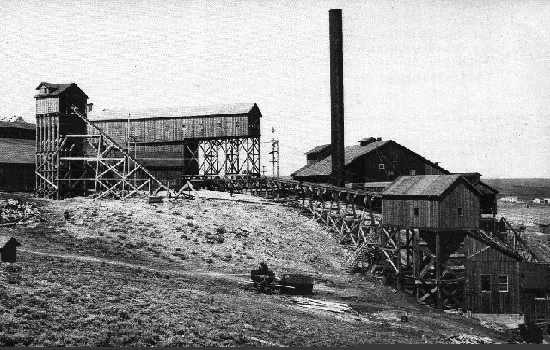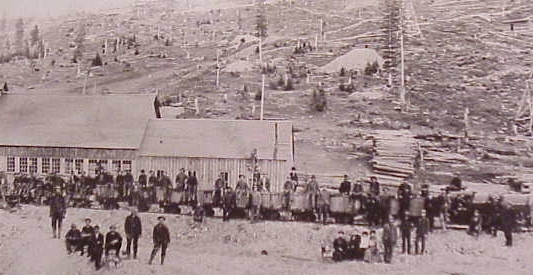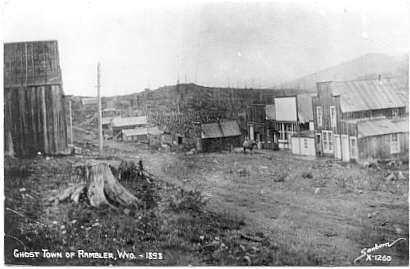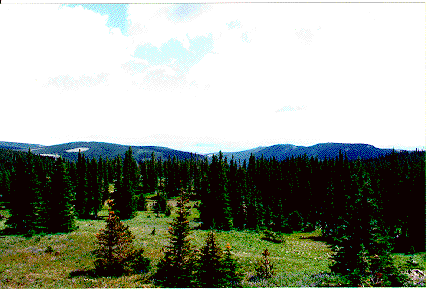
Rudaheha Mine, Battle, Wyoming, 1902, photo by J. E. Stimson.
For information as to J. E. Stimson see Cheyenne III.
The Rudafeha Mine, 14 miles from Encampment, was established by Rudolph, Davis, Ferris and Haggarty
and named after the investors. The ore from the Rudafeha Mine in Battle, Wyoming, was
carried to the smelter in Encampment
on the world's longest aerial tramway, photos of tramway in Encampment on
preceding page. Battle was named as
a result of a battle fought between 500 Sioux, Arapaho and Cheyenne and 23 Rocky Mountain Fur
Company trappers. The mines in the area were abandoned in 1908 with
the loss of value in copper and the indictment of the company for
stock fraud. When the shafts of the Rudafeha Mine were sealed no provision
was made for drainage and the shafts are now flooded with some seepage poluting nearby
steams.

Rudafeha Mine, Battle, Wyoming, prior to 1908
In the cloudy crystal ball department, in 1907, the State Geologist Henry C. Beeler reported as to the
mines featured on this page:
The two mines of the Penn-Wyoming Copper Company,
the Ferris-Haggarty and the Doane-Rambler, are in active operation.
In the former some' new ore shoots have been opened and the mine bids
fair for a greater production than ever, as it has been put in
first-class physical shape and the ore handled at a less cost per
ton. Diamond drill prospecting has been going on in the lower levels
of this mine this year, exploring the adjacent formations for parallel
ore shoots, but the results have not yet been given to the public.
In the Doane-Rambler mine, work has been confined to reopening the
working levels, putting them in shape for a large production and
connecting the mine with the sixteen-mile overhead tramway, which
transports the ore from the Ferris-Haggarty mine to the Encampment
smelter and the railroad. There is no reason, why an active production
campaign should not be made, and the management of this enterprise is
to be congratulated on what it has accomplished, in the face of what
appeared to be almost insurmountable difficulties, in the way of fires,
scarcity of labor, financial depression and an arbitrary and needless
decline in the price of copper, which occurred just as it had completed
its new works and was prepared to produce at a handsome profit.
This new smelter and railroad have made the future of the Encampment
district a certainty, as there has never been any doubt as to the ores
here, and new work is going on all over the district.
As noted above, the mines closed the next year.

Rambler, Wyoming, 1891 |

Rambler, 1997 |
Rambler, located in the Grand Encampment Mining
District of southern Carbon County, was established by Rudolph, Davis, Ferris amd Haggarty
 as a part
of their copper mining operations. as a part
of their copper mining operations. (Bird's eye view of Rudafeha Mine, to right. Tramway terminal in
tall building at right of photo).
In 1998, The Wyoming State Geologic Survey, noting that the New Rambler mine
had in the early 1900's, in addition to copper, mined some platinum-group metals (PGM), reported
that there has been some renewed interest in exploration and claim staking for
PGM in the state.
|